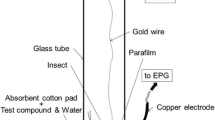Summary
In the feeding response ofHydra japonica evoked by reduced glutathione or S-methyl-gluta-thione, tentacles writhed, and were shrunk and intertwined resulting in the state termed tentacle ball formation (TBF).
A quantitative method for assaying the feeding response was devised making use of TBF. The assay was simple, reliable and highly sensitive for the response in PIPES buffer. EC50 (concentration at which 50% of the maximum response is obtained) for S-methyl-glutathione was as low as 10−8 M, about 2 orders of magnitude lower than has been reported earlier. Seven L-amino acids (arginine, isoleucine, leucine, lysine, ornithine, tryptophan and valine) among 21 amino acids examined were found to evoke a discernible TBF at 1 mM. The seven amino acids increased the fraction of animals swallowing the dead, fixedArtemia nauplii, as did S-methyl-glutathione.
The time course of the p t (the fraction of animals exhibiting TBF at t min after beginning of stimulus) was analyzed according to an experimental equation with 3 parametersr, n andT: p t = 2r/(1+exp(t/T) n). A strong correlation (correlation coefficient 0.89) betweenn andT was observed irrespective of various conditions (kinds of stimulants, concentrations). The correlation betweenr andn (orT) was weaker than that betweenn andT.
Similar content being viewed by others
Abbreviations
- GSH :
-
reduced glutathione
- GSM :
-
S-methyl-glutathione
- PIPES :
-
piperazine-N,N′-bis(2-ethanesulfonic acid)
- TBF :
-
tentacle ball formation
References
Brandt S (1976) Statistical and computational methods in data analysis. North-Holland, Amsterdam
Cliffe EE, Waley SG (1958) Effect of analogs of glutathione on the feeding reaction ofHydra. Nature 182:804–805
Fulton C (1963) Proline control of the feeding reaction ofCordylo-phora. J Gen Physiol 46:823–837
Hirakawa Y, Kijima H (1980) Behavioral analysis of glutathione receptor ofHydra I. Mouth-opening threshold, inhibition constant and their temperature dependence. J Comp Physiol 139:73–81
Koizumi O, Kijima H (1980) Specific S-methyl-glutathione incorporation into a nematocyst-rich fraction ofHydra. Biochim Biophys Acta 629:338–348
Lenhoff HM (1961) Activation of the feeding reflex inHydra litto-ralis I. Role played by reduced glutathione and quantitative assay of the feeding reflex. J Gen Physiol 45:331–344
Lenhoff HM (1965) Some physico-chemical aspects of the macro- and micro-environment surroundingHydra during activation of their feeding behavior. Am Zool 5:515–524
Lenhoff HM (1968a) Behavior, hormone and hydra. Science 161:434–442
Lenhoff HM (1968b) Chemical perspectives on the feeding response, digestion and nutrition of selected coelenterates. In: Florkin M, Scheer BT (ed) Chemical zoology, vol II. Academic Press, New York London, pp 157–221
Lenhoff HM, Bovaird J (1959) Requirement of bound calcium for the action of surface chemoreceptors. Science 130:1475–1476
Lenhoff HM, Bovaird J (1961) Action of glutamic acid and glutathione analogs on the hydra glutathione-receptor. Nature 189:486–487
Lenhoff HM, Brown RD (1970) Mass culture of hydra: an improved method and its application to other aquatic invertebrates. Lab Anim 4:139–154
Lentz TL (1968) Primitive nervous systems. Yale University Press, New Haven London
Loomis WF (1955) Glutathione control of the specific feeding reactionsof Hydra. Ann NY Acad Sci 62:211–227
Rushforth NB, Hofman F (1972) Behavioral and electrophysiological studies of Hydra. III. Components of feeding behavior. Biol Bull 142:110–131
Shoup TL, Rushforth NB, Stokes DR (1979) Is proline the sole feeding activator in the hydroidCordylophora? Am Zool 19:861
Spudich JL, Koshland DE Jr (1975) Quantitation of the sensory response in bacterial chemotaxis. Proc Natl Acad Sci USA 72:710–713
Author information
Authors and Affiliations
Additional information
The author thanks Prof. H. Morita, Drs. H. Kijima and O. Koizumi for stimulating discussions and advice and Mrs. E. Fukagawa for preparing the manuscript. He also thanks Dr. C. Rees for reading the manuscript.
Rights and permissions
About this article
Cite this article
Hanai, K. A new quantitative analysis of the feeding response inHydra japonica: Stimulatory effects of amino acids in addition to reduced glutathione. J. Comp. Physiol. 144, 503–508 (1981). https://doi.org/10.1007/BF01326835
Accepted:
Issue Date:
DOI: https://doi.org/10.1007/BF01326835



